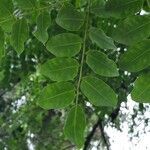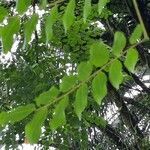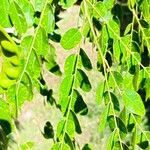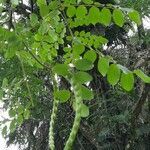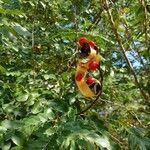A deciduous tree up to 7-20 m high. It spreads to 4 m across. It loses many of its leaves during the hot dry season of the year. The stem is erect and slender. The bark is smooth and light brown. The leaves are green and divided twice into leaflets. The whole leaf is 30-45 cm long. The leaf is divided into 3-5 pairs of segments 10-15 cm long. Each is divided again into 10-18 alternate oblong leaflets. These are 1.7-4 cm long by 0.8-2 cm wide. These leaflets are dark green on top and paler underneath. The flowers are small and white or yellow. They occur at the ends of branches. The fruit is a long (20 cm) dark brown pod with red seeds. The pod twists up as it opens. The seeds are shiny red and hard and 0.7-1 cm across. The pods remain on the tree long after ripening. It is a legume.
Trees 4–20 m. high.. Young branchlets usually glabrous.. Leaves up to 40 cm. long; pinnae 3–5 pairs; leaflets 5–9 on each side of the pinna-rhachis, elliptic to ovate-or obovate-elliptic, 1.5–4.5 cm. long, 1.2–2.3 cm. wide, shortly petiolulate, rounded at apex, minutely puberulous especially beneath (use × 20 lens).. Racemes 9–26 cm. long, glabrous or slightly puberulous; pedicels 2–3.5 cm. long.. Flowers yellowish.. Calyx 0.75–1 mm. long, usually glabrous.. Petals 3–4.5 mm. long.. Stamen-filaments 2.5–4 mm. long.. Pods 18–22 cm. long, 1.3–1.7 cm. wide, brown outside, after dehiscence the valves reflexing spirally to show the satiny-yellow inner surface and the rather persistent, scarlet, elliptic-lenticular, glossy seeds which are 8–10 × 7–9 mm.
Tree to 27 m tall, glabrous except sometimes branchlets and leaf axes ±puberulous. Pinnae (2–) 3-or 4 (–6)-jugate; leaflets 8-16, alternate, elliptic, oval or oblong, rounded-obtuse, 15–40 mm long, 10–25 mm wide, usually glabrous. Inflorescence racemose, 8–21 cm long. Flowers with pedicels 3–4 mm long, cream-coloured, becoming yellow; calyx shallowly cupular, c. 1 mm long with small teeth, glabrous or ± appressed-puberulous; petals 3 mm long, glabrous or sparsely appressed-puberulous. Pod linear, to 20 cm long, 14–17 mm wide, coriaceous, glabrous; valves tightly coiled or spirally twisted after dehiscence. Seeds ovaloid, oblongoid, widely obovoid or circular, compressed, 8–9.5 mm long, scarlet, glossy.
